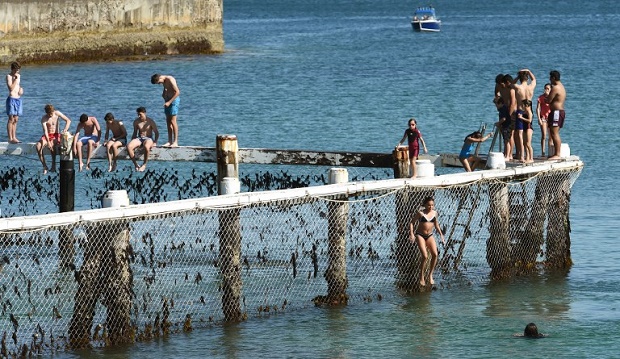Drones to circle Australia beaches to monitor sharks

Children play on a shark net at Little Manly Cove as shark experts assess cutting-edge technologies to counter attacks at a summit in Sydney on September 29, 2015, following an “unprecedented” spate of encounters in eastern Australia this year that has left one dead and seven injured. Australia is home to one of the world’s highest incidents of shark attacks, with the two-day summit, which include researchers from the US and South Africa, organised in part to address community fears after the recent incidents on the north coast of the most populous state New South Wales. AFP FILE PHOTO
SYDNEY, Australia — Drones will circle popular swimming spots in eastern Australia and “listening stations” track tagged sharks as part of a new strategy announced Sunday to keep beachgoers safe after a spate of bloody attacks.
The country has one of the world’s highest incidences of shark attacks with 13 in New South Wales this year leaving one dead and seven injured, threatening the beach tourism industry.
In response the nation’s most populous state, which has ruled out culling sharks, unveiled a five-year plan to address the issue, including next-generation sonar systems and boosted aerial surveillance.
The state’s primary industries minister Niall Blair said the multi-faceted approach followed advice from experts attending a recent shark summit in Sydney and community consultation.
“We are proud to be the first jurisdiction anywhere in the world to adopt an integrated approach toward keeping our beaches safe,” he said.
Article continues after this advertisementThe wide-ranging Aus$16 million (US$11.5 million) plan to protect swimmers and surfers, while minimising harm to sharks, will see the trial of drones to provide real-time vision, while boosting helicopter surveillance.
Article continues after this advertisementThe tagging of sharks will be stepped up, sonar detecting buoys deployed and 20 “listening stations” built at known hot spots using 4G technology to allow tagged animals to be monitored.
The real-time information will eventually be available to the public on a SharkSmart mobile app.
A Japanese surfer died in February after his legs were torn off by a shark and there have been 12 other serious attacks up and down the more than 2,000-kilometre-long (1,200-mile) NSW coast.
There were only three attacks in the state in 2014.
Experts say attacks are increasing as water sports become more popular and bait fish move closer to shore, but fatalities remain rare.
Part of the NSW funding will also be used to continue researching new technologies, including the use of electrical barriers powered by wave energy which omit low frequency pulsed signals to deter sharks.
How to manage sharks is a controversial issue with Western Australia state last year ditching a catch-and-kill policy using baited hooks and drum lines after community protests.
Under the policy, 72 baited hooks attached to floating drums were to be put in place between November and April each year until 2017 after a spate of attacks, with captured sharks killed if considered a threatening size.
More than 170 sharks, mostly tiger sharks, were caught during a 13-week trial, with 50 of the biggest ones destroyed.
Environmentalists said the policy was flawed, with no clear public safety outcomes but a heavy environmental cost, and it has now been abandoned.
RELATED STORIES
Shark attack? Misamis Or. fishers ‘saw’ sharks eating human remains